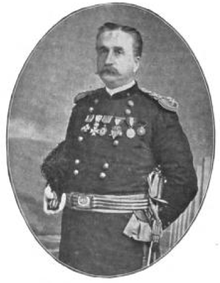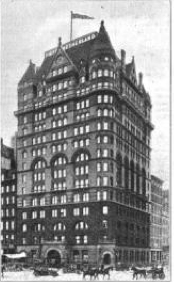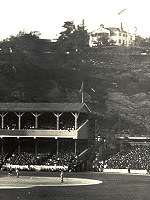Ferdinand P. Earle

Ferdinand Pinney Earle (1839 - January 2, 1903) was a US military officer and hotel proprietor.
Early life and family
Earle was born in Hartford, Connecticut in 1839.[1] His mother was Elizabeth (née Pinney), daughter of Judge Benjamin Pinney, of Ellington, Connecticut. His father, William Pitt Earle, was for many years a leading hotel proprietor in New York City, and at the time of his death, was one of the oldest men in that line of business. He was for many years proprietor of the Clinton House, of Hartford and later of the Lorillard House, New York, which was subsequently known and achieved a national reputation as Earle's Hotel.[1]
Hotel proprietor

After Earle completed his education, he came to New York and soon associated himself with his father, who had been proprietor of the Clinton House in Hartford, but had moved to New York and was then the proprietor of Earle's Hotel at Centre and Canal Streets, and in the course of a few years he succeeded his father as proprietor of this property. Afterward he established the Hotel Normandie at Broadway and 38th Street, and Normandie-by-the-Sea, a large summer hotel at Sea Bright, New Jersey. For a short time he was also manager of the Hotel Netherland, which was built for Earle by William Waldorf Astor.[1][2]
Military career
Earle was a prominent figure in the National Army and in the Grand Army of the Republic. His military career began Oct. 3, 1862, when he entered as private in Company B of the Seventh Regiment, N. Y., and was honorably discharged Oct. 29, 1869. In 1881, he re-entered military life as Captain of the Second Battery, N. G. N. Y., and became noted as one of the most efficient officers in the National Guard. The battery which he commanded was thereafter known as " Earle's Battery." Gen. Earle received his military title in 1889, when he was appointed Chief of Artillery with the rank of Brigadier-General on the staff of Governor Hill, with whom he was always on friendly terms, and he was re-appointed by Governor Flower. For ten years after his reentrance into military life he was chairman of the Auxiliary Committee of the Grand Army of the Republic. In 1884, he was decorated by the Venezuelan Government with the Order of the Bust of the Liberator in recognition of his services to that government.[2]
Society involvement
He was for many years chairman and treasurer of the Citizens' Auxiliary Committee of the G. A. R. His charitable and benevolent operations were well known, and the "Earle Guild," founded by him for the relief of the needy, accomplished much good in this direction. Earle was connected with many of the leading societies and organizations of the city. He was a member of the New York Chamber of Commerce, the New York Historical Society, New York Genealogical and Biographical Society, Huguenot Society of America, New England Society, National Rifle Association, Seventh Regiment Club, American Yacht Club, Order of the Founders and Patriots of America, Society of Colonial Wars, and Society of the War of 1812.[1]
Later years

After the termination of long litigation over the Jumel estate, Earle was able to purchase the historic "Jumel Mansion", famous as the place where George Washington made his headquarters during the Battle of Harlem Heights, in September, 1776. It is also where Alexander Hamilton and Aaron Burr met before their fatal duel. Here in this house, at 160th street, near 10th Avenue, New York City, built by a relative of Earle's ancestor, Capt. William Morris, he spent his retirement the last years of his life.[2] He had this building fitted up and restored as far as possible to its original condition and gave it the name of "Earle Cliff." Here, his wife, a Regent of the Washington Heights Chapter, Daughters of the American Revolution, entertained the Daughters and other patriotic societies. She was the founder and president of the Washington Heights Society, Children of the American Revolution.[1]
Personal life
Earle was twice married: first, to Mary Lay Hutchings; secondly, in 1871, to Lydia Jones Tuttle, widow of Doriphus Tuttle of Boston, Massachusetts. Besides his widow, there were four surviving sons by his second marriage: Ferdinand Pinney, Victor de La Montagne, William Pitt Striker, and Guyon Locke Crocheron.[2]
References
- 1 2 3 4 5 Whittemore, Henry (1897). The Heroes of the American Revolution and Their Descendants: Battle of Long Island (Public domain ed.). Heroes of the Revolution Publishing Company. pp. 51–.
- 1 2 3 4 "Obituaries". The New York Genealogical and Biographical Record. New York Genealogical and Biographical Society. 34 (2): 144–145. April 1903.
![]()
![]()